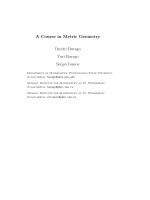- Trang chủ >>
- Khoa Học Tự Nhiên >>
- Vật lý
A course in fluid mechanics with vector field theory d prieve
Bạn đang xem bản rút gọn của tài liệu. Xem và tải ngay bản đầy đủ của tài liệu tại đây (1.34 MB, 198 trang )
A Course in Fluid Mechanics
with Vector Field Theory
by
Dennis C. Prieve
Department of Chemical Engineering
Carnegie Mellon University
Pittsburgh, PA 15213
An electronic version of this book in Adobe PDF® format was made available to
students of 06-703, Department of Chemical Engineering,
Carnegie Mellon University, Fall, 2000.
Copyright © 2000 by Dennis C. Prieve
06-703 1 Fall, 2000
Copyright © 2000 by Dennis C. Prieve
Table of Contents
ALGEBRA OF VECTORS AND TENSORS 1
VECTOR MULTIPLICATION 1
Definition of Dyadic Product 2
DECOMPOSITION INTO SCALAR COMPONENTS 3
SCALAR FIELDS 3
GRADIENT OF A SCALAR 4
Geometric Meaning of the Gradient 6
Applications of Gradient 7
CURVILINEAR COORDINATES 7
Cylindrical Coordinates 7
Spherical Coordinates 8
DIFFERENTIATION OF VECTORS W.R.T. SCALARS 9
VECTOR FIELDS 11
Fluid Velocity as a Vector Field 11
PARTIAL & MATERIAL DERIVATIVES 12
CALCULUS OF VECTOR FIELDS 14
GRADIENT OF A SCALAR (EXPLICIT) 14
DIVERGENCE, CURL, AND GRADIENT 16
Physical Interpretation of Divergence 16
Calculation of ∇
.
v in R.C.C.S 16
Evaluation of ∇×v and ∇v in R.C.C.S 18
Evaluation of ∇
.
v, ∇×v and ∇v in Curvilinear Coordinates 19
Physical Interpretation of Curl 20
VECTOR FIELD THEORY 22
DIVERGENCE THEOREM 23
Corollaries of the Divergence Theorem 24
The Continuity Equation 24
Reynolds Transport Theorem 26
STOKES THEOREM 27
Velocity Circulation: Physical Meaning 28
DERIVABLE FROM A SCALAR POTENTIAL 29
THEOREM III 31
TRANSPOSE OF A TENSOR, IDENTITY TENSOR 31
DIVERGENCE OF A TENSOR 32
INTRODUCTION TO CONTINUUM MECHANICS* 34
CONTINUUM HYPOTHESIS 34
CLASSIFICATION OF FORCES 36
HYDROSTATIC EQUILIBRIUM 37
FLOW OF IDEAL FLUIDS 37
EULER'S EQUATION 38
KELVIN'S THEOREM 41
IRROTATIONAL FLOW OF AN INCOMPRESSIBLE FLUID 42
Potential Flow Around a Sphere 45
d'Alembert's Paradox 50
06-703 2 Fall, 2000
Copyright © 2000 by Dennis C. Prieve
STREAM FUNCTION 53
TWO-D FLOWS 54
AXISYMMETRIC FLOW (CYLINDRICAL) 55
AXISYMMETRIC FLOW (SPHERICAL) 56
ORTHOGONALITY OF ψ=CONST AND φ=CONST 57
STREAMLINES, PATHLINES AND STREAKLINES 57
PHYSICAL MEANING OF STREAMFUNCTION 58
INCOMPRESSIBLE FLUIDS 60
VISCOUS FLUIDS 62
TENSORIAL NATURE OF SURFACE FORCES 62
GENERALIZATION OF EULER'S EQUATION 66
MOMENTUM FLUX 68
RESPONSE OF ELASTIC SOLIDS TO UNIAXIAL STRESS 70
RESPONSE OF ELASTIC SOLIDS TO PURE SHEAR 72
GENERALIZED HOOKE'S LAW 73
RESPONSE OF A VISCOUS FLUID TO PURE SHEAR 75
GENERALIZED NEWTON'S LAW OF VISCOSITY 76
NAVIER-STOKES EQUATION 77
BOUNDARY CONDITIONS 78
EXACT SOLUTIONS OF N-S EQUATIONS 80
PROBLEMS WITH ZERO INERTIA 80
Flow in Long Straight Conduit of Uniform Cross Section 81
Flow of Thin Film Down Inclined Plane 84
PROBLEMS WITH NON-ZERO INERTIA 89
Rotating Disk* 89
CREEPING FLOW APPROXIMATION 91
CONE-AND-PLATE VISCOMETER 91
CREEPING FLOW AROUND A SPHERE (Re→0) 96
Scaling 97
Velocity Profile 99
Displacement of Distant Streamlines 101
Pressure Profile 103
CORRECTING FOR INERTIAL TERMS 106
FLOW AROUND CYLINDER AS RE→0 109
BOUNDARY-LAYER APPROXIMATION 110
FLOW AROUND CYLINDER AS Re→ ∞ 110
MATHEMATICAL NATURE OF BOUNDARY LAYERS 111
MATCHED-ASYMPTOTIC EXPANSIONS 115
MAE’S APPLIED TO 2-D FLOW AROUND CYLINDER 120
Outer Expansion 120
Inner Expansion 120
Boundary Layer Thickness 120
PRANDTL’S B.L. EQUATIONS FOR 2-D FLOWS 120
ALTERNATE METHOD: PRANDTL’S SCALING THEORY 120
SOLUTION FOR A FLAT PLATE 120
Time Out: Flow Next to Suddenly Accelerated Plate 120
Time In: Boundary Layer on Flat Plate 120
Boundary-Layer Thickness 120
Drag on Plate 120
06-703 3 Fall, 2000
Copyright © 2000 by Dennis C. Prieve
SOLUTION FOR A SYMMETRIC CYLINDER 120
Boundary-Layer Separation 120
Drag Coefficient and Behavior in the Wake of the Cylinder 120
THE LUBRICATION APPROXIMATION 157
TRANSLATION OF A CYLINDER ALONG A PLATE 163
CAVITATION 166
SQUEEZING FLOW 167
REYNOLDS EQUATION 171
TURBULENCE 176
GENERAL NATURE OF TURBULENCE 176
TURBULENT FLOW IN PIPES 177
TIME-SMOOTHING 179
TIME-SMOOTHING OF CONTINUITY EQUATION 180
TIME-SMOOTHING OF THE NAVIER-STOKES EQUATION 180
ANALYSIS OF TURBULENT FLOW IN PIPES 182
PRANDTL’S MIXING LENGTH THEORY 184
PRANDTL’S “UNIVERSAL” VELOCITY PROFILE 187
PRANDTL’S UNIVERSAL LAW OF FRICTION 189
ELECTROHYDRODYNAMICS 120
ORIGIN OF CHARGE 120
GOUY-CHAPMAN MODEL OF DOUBLE LAYER 120
ELECTROSTATIC BODY FORCES 120
ELECTROKINETIC PHENOMENA 120
SMOLUCHOWSKI'S ANALYSIS (CA. 1918) 120
ELECTRO-OSMOSIS IN CYLINDRICAL PORES 120
ELECTROPHORESIS 120
STREAMING POTENTIAL 120
SURFACE TENSION 120
MOLECULAR ORIGIN 120
BOUNDARY CONDITIONS FOR FLUID FLOW 120
INDEX 211
06-703 1 Fall, 2000
Copyright © 2000 by Dennis C. Prieve
Algebra of Vectors and Tensors
Whereas heat and mass are scalars, fluid mechanics concerns transport of momentum, which is a
vector. Heat and mass fluxes are vectors, momentum flux is a tensor. Consequently, the mathematical
description of fluid flow tends to be more abstract and subtle than for heat and mass transfer. In an
effort to make the student more comfortable with the mathematics, we will start with a review of the
algebra of vectors and an introduction to tensors and dyads. A brief review of vector addition and
multiplication can be found in Greenberg,
♣
pages 132-139.
Scalar - a quantity having magnitude but no direction (e.g. temperature, density)
Vector - (a.k.a. 1st rank tensor) a quantity having magnitude and direction (e.g. velocity, force,
momentum)
(2nd rank) Tensor - a quantity having magnitude and two directions (e.g. momentum flux,
stress)
VECTOR MULTIPLICATION
Given two arbitrary vectors a and b, there are three types of vector products
are defined:
Notation Result Definition
Dot Product a
.
b scalar ab cosθ
Cross Product a×b vector absinθn
where θ is an interior angle (0 ≤ θ ≤ π) and n is a unit vector which is normal to both a and b. The
sense of n is determined from the "right-hand-rule"
♦
Dyadic Product ab tensor
♣
Greenberg, M.D., Foundations Of Applied Mathematics, Prentice-Hall, 1978.
♦
The “right-hand rule”: with the fingers of the right hand initially pointing in the direction of the first
vector, rotate the fingers to point in the direction of the second vector; the thumb then points in the
direction with the correct sense. Of course, the thumb should have been normal to the plane containing
both vectors during the rotation. In the figure above showing a and b, a×b is a vector pointing into the
page, while b×a points out of the page.
06-703 2 Fall, 2000
Copyright © 2000 by Dennis C. Prieve
In the above definitions, we denote the magnitude (or length) of vector a by the scalar a. Boldface will
be used to denote vectors and italics will be used to denote scalars. Second-rank tensors will be
denoted with double-underlined boldface; e.g. tensor T.
Definition of Dyadic Product
Reference: Appendix B from Happel & Brenner.
♥
The word “dyad” comes from Greek: “dy”
means two while “ad” means adjacent. Thus the name dyad refers to the way in which this product is
denoted: the two vectors are written adjacent to one another with no space or other operator in
between.
There is no geometrical picture that I can draw which will explain what a dyadic product is. It's best
to think of the dyadic product as a purely mathematical abstraction having some very useful properties:
Dyadic Product ab - that mathematical entity which satisfies the following properties (where a,
b, v, and w are any four vectors):
1. ab
.
v = a(b
.
v) [which has the direction of a; note that ba
.
v = b(a
.
v) which has the direction of
b. Thus ab ≠ ba since they don’t produce the same result on post-dotting with v.]
2. v
.
ab = (v
.
a)b [thus v
.
ab ≠ ab
.
v]
3. ab×v = a(b×v) which is another dyad
4. v×ab = (v×a)b
5. ab:vw = (a
.
w)(b
.
v) which is sometimes known as the inner-outer product or the double-dot
product.
*
6. a(v+w) = av+aw (distributive for addition)
7. (v+w)a = va+wa
8. (s+t)ab = sab+tab (distributive for scalar multiplication also distributive for dot and cross
product)
9. sab = (sa)b = a(sb)
♥
Happel, J., & H. Brenner, Low Reynolds Number Hydrodynamics, Noordhoff, 1973.
*
Brenner defines this as (a
.
v)(b
.
w). Although the two definitions are not equivalent, either can be
used as long as you are consistent. In these notes, we will adopt the definition above and ignore
Brenner's definition.
06-703 3 Fall, 2000
Copyright © 2000 by Dennis C. Prieve
DECOMPOSITION INTO SCALAR COMPONENTS
Three vectors (say e
1
, e
2
, and e
3
) are said to be linearly independent if none can be expressed
as a linear combination of the other two (e.g. i, j, and k). Given such a set of three LI vectors, any
vector (belonging to E
3
) can be expressed as a linear combination of this basis:
v = v
1
e
1
+ v
2
e
2
+ v
3
e
3
where the v
i
are called the scalar components of v. Usually, for convenience, we choose
orthonormal vectors as the basis:
e
i
.
e
j
= δ
ij
=
1
0
if
if
i j
i j
=
≠
R
S
T
although this is not necessary. δ
ij
is called the Kronecker delta. Just as the familiar dot and cross
products can written in terms of the scalar components, so can the dyadic product:
vw = (v
1
e
1
+v
2
e
2
+v
3
e
3
)(w
1
e
1
+w
2
e
2
+w
3
e
3
)
= (v
1
e
1
)(w
1
e
1
)+(v
1
e
1
)(w
2
e
2
)+
= v
1
w
1
e
1
e
1
+v
1
w
2
e
1
e
2
+
(nine terms)
where the e
i
e
j
are nine distinct unit dyads. We have applied the definition of dyadic product to
perform these two steps: in particular items 6, 7 and 9 in the list above.
More generally any nth rank tensor (in E
3
) can be expressed as a linear combination of the 3
n
unit n-
ads. For example, if n=2, 3
n
=9 and an n-ad is a dyad. Thus a general second-rank tensor can be
decomposed as a linear combination of the 9 unit dyads:
T = T
11
e
1
e
1
+T
12
e
1
e
2
+
= Σ
i=1,3
Σ
j=1,3
T
ij
e
i
e
j
Although a dyad (e.g. vw) is an example of a second-rank tensor, not all
2nd rank tensors T can be expressed as a dyadic product of two vectors.
To see why, note that a general second-rank tensor has nine scalar
components which need not be related to one another in any way. By
contrast, the 9 scalar components of dyadic product above involve only six
distinct scalars (the 3 components of v plus the 3 components of w).
After a while you get tired of writing the summation signs and limits. So an
abbreviation was adopted whereby repeated appearance of an index implies summation over the three
allowable values of that index:
T = T
ij
e
i
e
j
06-703 4 Fall, 2000
Copyright © 2000 by Dennis C. Prieve
This is sometimes called the Cartesian (implied) summation convention.
SCALAR FIELDS
Suppose I have some scalar function of position (x,y,z) which is continuously differentiable, that
is
f = f(x,y,z)
and ∂f/∂x, ∂f/∂y, and ∂f/∂z exist and are continuous throughout some 3-D region in space. This
function is called a scalar field. Now consider f at a second point which is differentially close to the
first. The difference in f between these two points is
called the total differential of f:
f(x+dx,y+dy,z+dz) - f(x,y,z) ≡ df
For any continuous function f(x,y,z), df is linearly related
to the position displacements, dx, dy and dz. That
linear relation is given by the Chain Rule of
differentiation:
df
f
x
dx
f
y
dy
f
z
dz= + +
∂
∂
∂
∂
∂
∂
Instead of defining position using a particular coordinate
system, we could also define position using a position vector r:
r i
j
k
=
+
+
x
y
z
The scalar field can be expressed as a function of a vector argument, representing position, instead of a
set of three scalars:
f = f(r)
Consider an arbitrary displacement away from the point r, which we denote as dr to emphasize that the
magnitude dr of this displacement is sufficiently small that f(r) can be linearized as a function of
position around r. Then the total differential can be written as
06-703 5 Fall, 2000
Copyright © 2000 by Dennis C. Prieve
df
f
d
f
=
+
−
(
)
(
)
r
r
r
GRADIENT OF A SCALAR
We are now is a position to define an important vector associated
with this scalar field. The gradient (denoted as ∇f) is defined
such that the dot product of it and a differential displacement
vector gives the total differential:
df
d
f
≡
∇
r
.
EXAMPLE: Obtain an explicit formula for calculating the gradient in Cartesian* coordinates.
Solution: r = xi + yj + zk
r+dr = (x+dx)i + (y+dy)j + (z+dz)k
subtracting: dr = (dx)i + (dy)j + (dz)k
∇f = (∇f)
x
i + (∇f)
y
j + (∇f)
z
k
dr
.
∇f = [(dx)i + ]
.
[(∇f)
x
i + ]
df = (∇f)
x
dx + (∇f)
y
dy + (∇f)
z
dz (1)
Using the Chain rule: df = (∂f/∂x)dx + (∂f/∂y)dy + (∂f/∂z)dz (2)
According to the definition of the gradient, (1) and (2) are identical. Equating them and collecting terms:
[(∇f)
x
-(∂f/∂x)]dx + [(∇f)
y
-(∂f/∂y)]dy + [(∇f)
z
-(∂f/∂z)]dz = 0
Think of dx, dy, and dz as three independent variables which can assume an infinite number of values,
even though they must remain small. The equality above must hold for all values of dx, dy, and dz. The
only way this can be true is if each individual term separately vanishes:**
*
Named after French philosopher and mathematician René Descartes (1596-1650), pronounced "day-
cart", who first suggested plotting f(x) on rectangular coordinates
**
For any particular choice of dx, dy, and dz, we might obtain zero by cancellation of positive and
negative terms. However a small change in one of the three without changing the other two would cause
the sum to be nonzero. To ensure a zero-sum for all choices, we must make each term vanish
independently.
06-703 6 Fall, 2000
Copyright © 2000 by Dennis C. Prieve
So (∇f)
x
= ∂f/∂x, (∇f)
y
= ∂f/∂y, and (∇f)
z
= ∂f/∂z,
leaving ∇ = + +f
f
x
f
y
f
z
∂
∂
∂
∂
∂
∂
i j k
Other ways to denote the gradient include:
∇f = gradf = ∂f/∂r
Geometric Meaning of the Gradient
1) direction: ∇f(r) is normal to the f=const surface passing through the point r in the direction of
increasing f. ∇f also points in the direction of steepest ascent of f.
2) magnitude: |∇f| is the rate of change of f with
distance along this direction
What do we mean by an "f=const surface"? Consider an
example.
Example: Suppose the steady state temperature profile
in some heat conduction problem is given by:
T(x,y,z) = x
2
+ y
2
+ z
2
Perhaps we are interested in ∇T at the point (3,3,3)
where T=27. ∇T is normal to the T=const surface:
x
2
+ y
2
+ z
2
= 27
which is a sphere of radius 27 .
♣
Proof of 1). Let's use the definition to show that these geometric meanings are correct.
df = dr
.
∇f
♣
A vertical bar in the left margin denotes material which (in the interest of time) will be omitted from the
lecture.
06-703 7 Fall, 2000
Copyright © 2000 by Dennis C. Prieve
Consider an arbitrary f. A portion of the f=const surface
containing the point r is shown in the figure at right. Choose a
dr which lies entirely on f=const. In other words, the surface
contains both r and r+dr, so
f(r) = f(r+dr)
and df = f(r+dr)-f(r) = 0
Substituting this into the definition of gradient:
df = 0 = dr
.
∇f = dr∇fcosθ
Since dr and ∇f are in general not zero, we are forced
to the conclusion that cosθ=0 or θ=90°. This means that ∇f is normal to dr which lies in the surface.
2) can be proved in a similar manner: choose dr to be parallel to ∇f. Does ∇f point toward higher or
lower values of f?
Applications of Gradient
• find a vector pointing in the direction of steepest ascent of some scalar field
• determine a normal to some surface (needed to apply b.c.’s like n
.
v = 0 for a boundary which is
impermeable)
• determine the rate of change along some arbitrary direction: if n is a unit vector pointing along some
path, then
n
.
∇ =f
f
s
∂
∂
is the rate of change of f with distance (s) along this path given by n.
∂
∂
f
s
is called the directed
derivative of f.
CURVILINEAR COORDINATES
In principle, all problems in fluid mechanics and transport could be solved using Cartesian
coordinates. Often, however, we can take advantage of symmetry in a problem by using another
coordinate system. This advantage takes the form of a reduction in the number of independent variables
(e.g. PDE becomes ODE). A familiar example of a non-Cartesian coordinate system is:
06-703 8 Fall, 2000
Copyright © 2000 by Dennis C. Prieve
Cylindrical Coordinates
r = (x
2
+y
2
)
1/2
x = rcosθ
θ = tan
-1
(y/x) y = rsinθ
z = z z = z
Vectors are decomposed differently. Instead of
in R.C.C.S.: v = v
x
i + v
y
j + v
z
k
in cylindrical coordinates, we write
in cyl. coords.: v = v
r
e
r
+
v
θ
e
θ
+ v
z
e
z
where e
r
, e
θ
, and e
z
are new unit vectors pointing the r, θ and z directions. We also have a different
set of nine unit dyads for decomposing tensors:
e
r
e
r
, e
r
e
θ
, e
r
e
z
, e
θ
e
r
, etc.
Like the Cartesian unit vectors, the unit vectors in cylindrical coordinates form an orthonormal set of
basis vectors for E
3
. Unlike Cartesian unit vectors, the orientation of e
r
and e
θ
depend on position. In
other words:
e
r
= e
r
(θ)
e
θ
= e
θ
(θ)
06-703 9 Fall, 2000
Copyright © 2000 by Dennis C. Prieve
Spherical Coordinates
Spherical coordinates (r,θ,φ) are defined relative to Cartesian coordinates as suggested in the
figures above (two views of the same thing). The green surface is the xy-plane, the red surface is the
xz-plane, while the blue surface (at least in the left image) is the yz-plane. These three planes intersect at
the origin (0,0,0), which lies deeper into the page than (1,1,0). The straight red line, drawn from the
origin to the point (r,θ,φ)
♣
has length r, The angle θ is the angle the red line makes with the z-axis (the
red circular arc labelled θ has radius r and is subtended by the angle θ). The angle φ (measured in the
xy-plane) is the angle the second blue plane (actually it’s one quadrant of a disk) makes with the xy-
plane (red). This plane which is a quadrant of a disk is a φ=const surface: all points on this plane have
the same φ coordinate. The second red (circular) arc labelled φ is also subtended by the angle φ.
♣
This particular figure was drawn using r = 1, θ = π/4 and φ = π/3.
06-703 10 Fall, 2000
Copyright © 2000 by Dennis C. Prieve
A number of other φ=const planes are
shown in the figure at right, along with a
sphere of radius r=1. All these planes
intersect along the z-axis, which also passes
through the center of the sphere.
( )
222
122
1
sincos
sinsintan
costan
xrrxyz
yrxyz
zryx
−
−
=θφ=+++
=θφθ=+
=θφ=
The position vector in spherical coordinates
is given by
r = xi+yj+zk = r e
r
(θ,φ)
In this case all three unit vectors depend on
position:
e
r
= e
r
(θ,φ), e
θ
= e
θ
(θ,φ), and e
φ
= e
φ
(φ)
where e
r
is the unit vector pointing the direction of increasing r, holding θ and φ fixed; e
θ
is the unit
vector pointing the direction of increasing θ, holding r and φ fixed; and e
φ
is the unit vector pointing the
direction of increasing φ, holding r and θ fixed.
These unit vectors are shown in the figure at right.
Notice that the surface φ=const is a plane containing the
point r itself, the projection of the point onto the xy-plane
and the origin. The unit vectors e
r
and e
θ
lie in this plane
as well as the Cartesian unit vector k (sometimes
denoted e
z
).
If we tilt this φ=const plane
into the plane of the page (as in the sketch at left), we can more easily see
the relationship between these three unit vectors:
(
)
(
)
cossin
zrθ
=θ−θ
eee
This is obtained by determined from the geometry of the right triangle in
the figure at left. When any of the unit vectors is position dependent, we
say the coordinates are:
k
unit circle on
= const
surface
φ
θ
06-703 11 Fall, 2000
Copyright © 2000 by Dennis C. Prieve
curvilinear - at least one of the basis vectors is position dependent
This will have some profound consequences which we will get to shortly. But first, we need to take
“time-out” to define:
DIFFERENTIATION OF VECTORS W.R.T. SCALARS
Suppose we have a vector v which depends on the scalar parameter t:
v = v(t)
For example, the velocity of a satellite depends on time. What do we mean by the “derivative” of a
vector with respect to a scalar. As in the Fundamental Theorem of Calculus, we define the derivative
as:
d
dt
t t t
t
t
v v v
=
( + ) - ( )
lim
∆
∆
∆
→
R
S
T
U
V
W
0
Note that dv/dt is also a vector.
EXAMPLE: Compute de
r
/dθ in cylindrical coordinates.
Solution: From the definition of the derivative:
d
d
r r r r
e e e e
θ
θ θ
=
+ −
R
S
T
U
V
W
=
R
S
T
U
V
W
→ →
lim
( ) ( )
lim
∆θ ∆θ
∆θ
∆θ
∆
∆θ
0 0
Since the location of the tail of a vector is not part
of the definition of a vector, let's move both
vectors to the origin (keeping the orientation
fixed). Using the parallelogram law, we obtain the
difference vector. Its magnitude is:
e e
r r
( ) ( ) sinθ θ+ − =∆θ
∆θ
2
2
Its direction is parallel to e
θ
(θ+∆θ/2), so:
e e e
r r
( ) ( ) sinθ θ θ
θ
+ − = +∆θ
∆θ ∆θ
2
2 2
e
j
Recalling that sinx tends to x as x→0, we have
06-703 12 Fall, 2000
Copyright © 2000 by Dennis C. Prieve
lim ( ) ( )
∆θ
∆θ ∆θ
→
+ − =
0
e e e
r r
θ θ θ
θ
l
q
c
h
Dividing this by ∆θ, we obtain the derivative:
de
r
/dθ = e
θ
Similarly, de
θ
/dθ = -e
r
One important application of “differentiation with respect to a
scalar” is the calculation of velocity, given position as a function of
time. In general, if the position vector is known, then the velocity
can be calculated as the rate of change in position:
r = r(t)
v = dr/dt
Similarly, the acceleration vector a can be calculated as the
derivative of the velocity vector v:
a = dv/dt
EXAMPLE: Given the trajectory of an object in
cylindrical coordinates
r = r(t), θ = θ(t), and z = z(t)
Find the velocity of the object.
Solution: First, we need to express r in in terms of the
unit vectors in cylindrical coordinates. Using the figure at
right, we note by inspection that
*
r(r,θ,z) = re
r
(θ) + ze
z
Now we can apply the Chain Rule:
*
Recalling that r = xi + yj + zk in Cartesian coordinates, you might be tempted to write r = re
r
+ θe
θ
+
ze
z
in cylindrical coordinates. Of course, this temptation gives the wrong result (in particular, the units
of length in the second term are missing).









